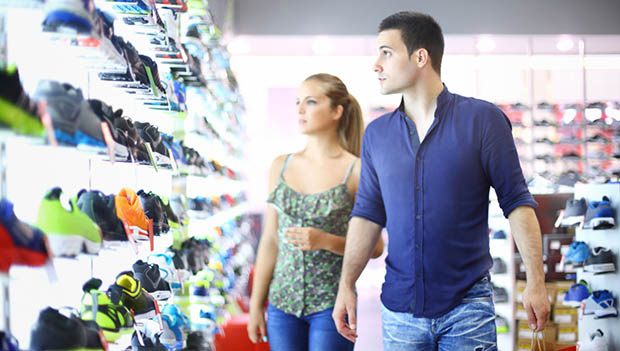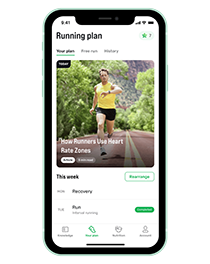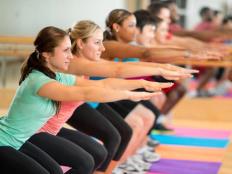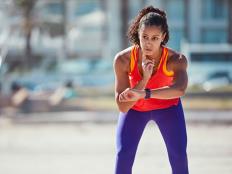
By clicking on the product links in this article, we may receive a commission fee at no cost to you, the reader. Sponsorships and affiliate commissions help support our research so we can help you find the best products. Read our full affiliate disclosure here.
Whether you've been logging miles for years, training for a 5k or 10k, or are just getting started with a beginner running app, choosing the best running shoes is an important part of the process. A well-fitting shoe can go a long way in making runs comfortable and preventing injury. While it's always a good idea to visit a specialty running shop to get fitted and try on a few options, it might be easier to choose a pair of running shoes online if you know what you're looking for (just be sure to look for a generous return policy).
Getting new running shoes? Then get JOGGO, the best running app to help you reach your goals:
Before you pick up the new Nike Pegasus 40 or start adding any shoes to your cart, there are a couple of factors to consider, like the wear pattern on your current shoes. The wear pattern can show how you pronate, which is a key factor in our running shoe guide. If the sole is worn on the ball of the foot, you're most likely a normal pronator. Excessive wear on the inside of the sole usually indicates something called overpronation and wear on the outside of the shoe often indicates supination (or under pronation). Knowing these wear patterns, as well as preferences when it comes to cushioning, will go a long way in choosing the best shoe for you.
If you're ready to get into the nitty-gritty of all things running shoes, you've come to the right place. We break down the main factors you should consider in this comprehensive running shoe guide. From heel to toe drop, to running location, we cover it all.
Why Trust Us?
ACTIVE.com's editorial team relies on the knowledge and experience of fitness and wellness experts including competitive athletes, coaches, physical therapists, nutritionists, and certified trainers. This helps us ensure the products we feature are of the highest standard. Collectively, the team has spent countless hours researching equipment, gear, and recovery tools in order to create the most accurate, authentic content for our readers. Customer satisfaction is also a key part of our review process, which is why we only feature products that are highly rated. More importantly, each member of our team is a fitness enthusiast. Fitness may be our job, but it is also our passion. Therefore, we strive to bring you products that we trust and would personally use.
Anatomy of a Running Shoe
If up until this point you've based your running shoe choices on just color or style, know that you're only touching the tip of the iceberg. There are over a dozen individual parts that make up a running shoe. Each piece works to provide support, stability, protection, and comfort and the specs can differ a ton from shoe to shoe. There’s no wrong answer when it comes to the details—the only thing that matters is how the shoe feels on your foot.
- Upper: The upper is made of fabric and mesh, and usually refers to everything above the sole of the shoe. Look for an upper that has smooth seams to minimize chafing and blisters.
- Outer: Different outsole combinations of foam and rubber can provide a mix of durability and protection. Keep in mind that the more durable the outsole, the more weight it’s likely to add, so finding the right balance for you may take some trial and error.
- Midsole: The midsole cushioning is sandwiched between the shoe’s outsole and the mesh or fabric upper. This section of the shoe serves to cushion the foot from the impact of hitting the ground. The amount of cushioning is a personal preference, so be sure to try a few types before committing.
- Heel counter: The heel counter is a cup that’s situated near the rearfoot and serves to provide support and stability upon landing.
- Ankle collar: The ankle collar is the padding near the, you guessed it, ankle. The padding serves to hold the ankle down and keep the foot secure. Some ankle collars might rub or cause Achilles tendon irritation, so this is an important feature to test.
- Toe box: The toe box is at the very end of your shoe located between the laces and the beginning of the sole. Look for a shape that allows your toes to spread naturally. Some trail running shoes are reinforced in this area to prevent stubs.
- Toe spring: The toe spring is the upward curvature of the toe box. It keeps the toes flexed upward and helps the foot move forward in its stride.
- Saddle: The saddle is the part of the shoe that’s near the laces. The saddle works in conjunction with the eyelets and laces to keep the foot secure. To make sure the saddle is sturdy and keeps your foot in place, make sure the shoe doesn’t slip and that you don’t experience any rubbing while wear-testing the shoe.
- Forefoot cushioning: Shoes can be well-cushioned and still have a low drop, but the key here is to have a similar amount of cushioning in the heel and forefoot areas. Keep in mind that more cushioning often means added weight. That’s not necessarily a bad thing for all runners, but something to pay attention to if you’re in the market for racing shoes.
- Heel cushioning: Heel cushioning is mainly a matter of preference. Do you like that weightless feeling that mimics running on clouds? Or do you prefer more contact with the ground? Be sure to consider your own comfort preferences when browsing different options.
- Heel to forefoot drop: The drop of a shoe is the angle between the heel/rearfoot and the toe/forefront. The greater the angle, the bigger the drop. Many traditional running shoes have a drop of about 10mm, and the extra cushioning in the rear serves to absorb impact. Many shoes on the market now have a lower (or even zero) drop, which encourages a mid-foot strike (vs. heel striking).
- Stability features: Many stability and motion control shoes include things like medial posts and guard rails to keep the foot in a more neutral pronation position. Stability features are most important to runners who tend to overpronate, which is when the outer edge of the heel hits the ground first with the foot rolling inwards onto the arch.
- Sockliner: This is the removable foam pad at the bottom of your shoe. Depending on the shoe, the liner can offer a lot of cushioning, or only minimal padding and arch support. Some runners like to replace this with their own custom insole or orthotic, which are special shoe or heel inserts that are custom-made for you (usually prescribed by a doctor).

What to Look for in Running Shoes
Running Location
- Road running: Will you be doing most of your miles on the road or on the treadmill? Look for shoes that are characterized as road running shoes. They likely have the appropriate amount of cushion to protect your bones, ligaments, tendons, and muscles from the impact of a harder surface.
- Trail running: If you're more of a trail runner, choose a shoe that’s tailored to uneven surfaces. Trail running shoes often have grippy soles, lugs for traction, and a stiffer heel collar to prevent rolled ankles. They may also include weather-proofing for wet or muddy runs.
- Cross training: Running shoes work great for miles on the road or treadmill, but if you plan to mix in cross-training you might want to consider another type of shoe. Many people prefer a thin-soled shoe for strength training, as too much cushioning could cause a rolled ankle when you do cross body or lateral movements. Likewise, if you do activities with a lot of side-to-side movement (aerobics classes, basketball, tennis), look for a shoe with a mix of cushioning and stability.
- Track spikes or road racing flats: If you compete in races, you might want to consider a specialty pair of running shoes. Track spikes help with traction while road racing flats are often very lightweight. Some new competition shoes now feature a carbon plate for increased performance.
Cushioning
- Maximum: If you like your feet to be well-padded, look for running shoes with more cushioning. Maximum cushioning is often good for runners with high arches.
- Moderate: Many running shoes are a good balance of not too firm and not too soft. Runners with neutral pronation and neutral arches might prefer moderate cushioning.
- Minimal: Sometimes less is more: If you’re looking for a lightweight shoe, the lack of cushioning may actually encourage a lower impact forefoot/midfoot strike. This could ultimately lead to less pounding, but keep in mind that switching to this style suddenly might increase stress on the Achilles tendon and forefoot.
- Barefoot: Remember the popularity of Vibram five fingers running shoes? Although their popularity has waned since the mid-2000s, some runners still prefer a very minimal shoe. These shoes mimic barefoot running with very minimal cushioning and a zero drop.
- Drop: A shoe’s drop is essentially the difference in height between the heel and forefoot—the higher the number, the greater the angle. For example, in a barefoot running shoe, the drop is close to 0, but with high heels, it might be a 10. Shoes with a bigger drop are generally suited toward heel strikers while lower drop shoes (6mm or less) are best for forefoot or midfoot strikers. One thing to remember: A shoe can have a lot of cushioning and still have a low drop. It’s all about the difference in stack height.
Support
- Pronation: Pronation describes the way your foot rolls inward when you hit the ground. It’s a natural movement, but sometimes runners over or under pronate.
- Overpronation: When the foot rolls too far inward, this is overpronation. A stability shoe with a medial post or other motion control features can limit overpronation and help the shoe wear more evenly.
- Supination: On the other end of the spectrum, supination (or underpronation) Is when the foot rolls too far outward. Supinators often do well in neutral shoes or shoes built with extra cushioning on the outside.
- Arches: Arch shape is related to pronation. The type of arch your feet exhibit can easily be divided into three categories: low, high, and neutral. To see which type of arch you have, stand up and put weight evenly on both feet. Look at your arches. Does your arch almost touch the floor? Does your foot or ankle roll in? People with low arches tend to have stability issues like overpronation. Is your arch really high? Can you almost fit a golf ball under your instep? The high-arched foot usually has the opposite problem. That means your foot rolls to the outside or supinates. If your arch is somewhere in the middle, that means you probably have neutral arches.
- Shoe support levels: Depending on your arch shape and whether you overpronate, supinate, or have a neutral foot stride, you might want to consider a specific level of support. Overpronators and low-arched runners often do well in motion control/stability shoes, supinators with high arches often do well in neutral or cushioned shoes, and runners with regular pronation and neutral arches can usually choose whatever feels best on their foot.
Fit
- To ensure the correct size, it's a good idea to measure your feet (even if you think you know your size). If you're at home, you can use a Brannock device to measure your foot's length/width/arch height or visit a retailer (such as Fleet Feet Sports) that uses 3D foot scanning technology. Women's feet often change size during and after pregnancy, so if you're a female runner that's something to keep in mind.
- Avoid trying on shoes in the morning. The best time to wear test running shoes is in the afternoon. Feet swell as the day goes on, so measure later in the day to ensure you don't buy running shoes that are too small.
- Try your accessories on with the shoe—that includes insoles, orthotics, and running socks.
Final Thoughts on How to Choose Your Running Shoes
At the end of the day, there's no one perfect shoe, there's only the best shoe for you. To maximize your chance of success, visit a specialty running store and have them analyze your arches, gait, and running routine. Don't forget to include your insoles, orthotics, and running socks as you test them out.
Want to find a great deal online? Do your research ahead of time and try to suss out any special needs before you click "add to cart." And of course, the ability to try your shoes on at home and then potentially return them is key.
Purchasing a pair of running shoes isn't cheap or easy, but a little leg work can go a long way in making your miles comfortable.
FAQs About Running Shoes
Do running shoes make a difference?
You might be tempted to pick up any shoe that's on sale or looks cool, but a shoe made specifically for running is really what you need. Running shoes provide the best protection for your feet, legs, and body from the repeated stress of thousands of foot landings per mile. Each time you take a stride and land, your foot must absorb two to three times your body weight. This repeated impact is different from other sports.
Running shoes have built-in features that enable you to run longer distances more comfortably and with less chance of overuse injury. Some of the things that set running shoes apart are superior cushioning, flexibility where you need it, stability or motion control, traction on roads or trails, torsional stability (stiffness where you need it), breathability, and night-time reflectivity. Also, keep in mind that a specialty running shoe store can do more than fitting: They can also help you choose any additional training accessories and nutrition products you'll need.
Is it ok to walk in running shoes?
Yes—running shoes can offer a broader range of cushioning and support than walking shoes, so they’re a great choice no matter how fast or slow you move. Walking is also a great way to ease into running, so once you feel comfortable in your walking routine, you can start adding short run intervals. Just keep in mind that any mileage you log (walking or running) counts against wear and tear, so you should still aim to replace shoes every 300-500 miles or so.
What are the three types of running shoes?
The three main types of running shoes are: stability, neutral, and cushioned. While there are some subgroups amongst the types (motion control shoes are a more extreme form of stability shoes and barefoot running shoes are a very minimal type of neutral shoes), it’s easier to start with the three main types first before delving into niche categories.
Get ACTIVE on the Go


Couch to 5K®
The best way to get new runners off the couch and across the finish line of their first 5K.
Available for iOS | Android









Discuss This Article